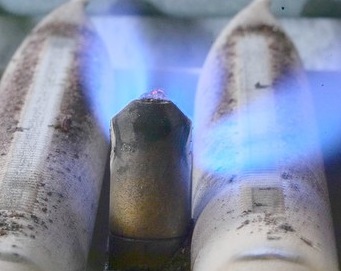Pilot Lights
A pilot light is a small flame that is kept alight constantly in order to serve as an ignition source for a gas burner. They are used on many natural gas and propane appliances, such as water heaters, clothes dryers, central heating systems, fireplaces and stoves.

Safety
- a photo-resistor, which detects the light emitted by the pilot light;
- a thermometer, which detects the heat created by the pilot light; or
- a voltmeter, which detects the electrical current created by the heat of the flame as it warms a thermocouple. A thermocouple is a device that creates a voltage related to the temperature difference at the junction of two different metals.
Natural gas and propane can usually be detected by building occupants by their odor, which is added to these naturally odorless fuels specifically to alert people to a lurking danger. Numerous injuries have been reported, however, when homeowners have tried to re-light a pilot light after the appliance’s malfunctioning sensor failed to stop the flow of gas into the room. Thermocouples are degraded by continued exposure to the pilot light’s flame, which increases their electrical resistance and reduces their effectiveness as flame sensors. Periodic testing and replacement of these devices will mitigate the safety hazards posed by pilot light-equipped appliances.
While many inspectors and homeowners may not be aware of the danger, a number of houses are destroyed every year when a pilot light ignites the explosive gasses released from insecticide "bug bombs" and foggers. A fire erupted in a Newburgh, Ohio house after a man placed a roach fumigator under his kitchen sink and the fumes reached his oven’s pilot light. Even worse, when homeowners employ a recklessly large number of these foggers, they can generate enough gas to create a catastrophic explosion, and the determination of homeowners driven mad by cockroaches and fleas is occasionally enough incentive for them to employ such overkill. In one case, 19 foggers were  unleashed in a 470-square foot San Diego home, filling the building with so much gas that the pilot light destroyed the home and launched shrapnel into the street. Fortunately, foggers are typically used in buildings that have been vacated. Three men were hospitalized, however, when an oven's pilot light in a Thai restaurant in Perth, Australia ignited the gas released from 36 foggers – enough to blow the roof off the building in a massive explosion that rocked the suburban neighborhood, causing $500,000 in damages.
unleashed in a 470-square foot San Diego home, filling the building with so much gas that the pilot light destroyed the home and launched shrapnel into the street. Fortunately, foggers are typically used in buildings that have been vacated. Three men were hospitalized, however, when an oven's pilot light in a Thai restaurant in Perth, Australia ignited the gas released from 36 foggers – enough to blow the roof off the building in a massive explosion that rocked the suburban neighborhood, causing $500,000 in damages.
Energy Waste
Pilot lights are not needed for the majority of the time that they’re lit, which is how they waste a large amount of fuel. The exact amount of energy wasted depends on the unit, but various studies report that a pilot light burns $7.50 to $18 per month of natural gas, and even more for propane-fueled appliances. They waste more than 20% of the gas used in the United States, according to Cornell Environmental Health and Safety. A constantly burning pilot light also adds heat to the house, which might be useful in the winter, but adds to the heat load in the summer and places an unnecessarily greater burden on the air-conditioning system. Even in the winter, the appliance may be located in a utility room or other area that doesn’t require heating. Also, a typical pilot light can generate 450 pounds of carbon dioxide – a greenhouse gas -- over a six-month period.
If an appliance isn’t needed for a long period of time, its pilot light may be extinguished to save energy, reduce greenhouse gas emissions, and reduce the risk of fire or explosion. Concerned homeowners can also purchase appliances equipped with the aforementioned alternatives to the pilot light. If they have any additional issues or concerns related to pilot lights or fuel-burning appliances, they should consult with an InterNACHI inspector during their next scheduled inspection.
In summary, pilot lights are a somewhat antiquated technology plagued by fears concerning fire and energy waste.

